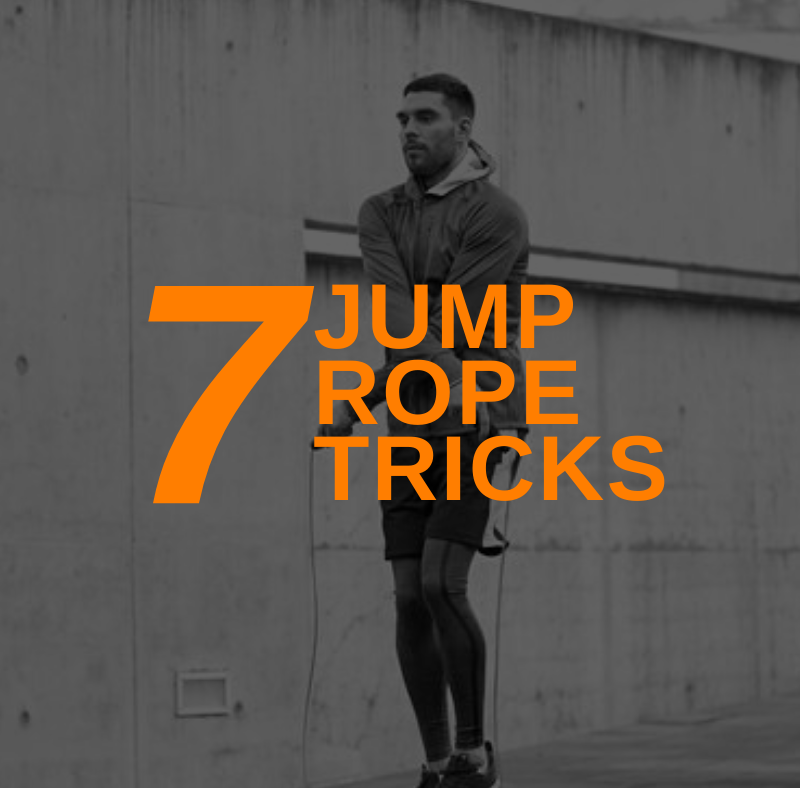
From little girls in the schoolyard to big, burly boxers, jump rope is a universally popular and accessible mode form of exercise. As a personal trainer, it’s a great one to introduce into workout sessions, too. Jumping rope is a full-body workout that can condition your body and help you lose fat, burning up to 10 calories per minute. It offers numerous health benefits and requires minimal equipment.
Initially, it can take a while to get the basics right. Using a jump rope requires a high level of cardiovascular fitness, coordination, and perhaps a few stinging shins before you get into the rhythm. But once you’ve mastered the simple technique, the routine can start to get monotonous.
Some of the more advanced tricks are geared toward the sort of jump rope you see in playgrounds that requires three people. But we’re going to stay away from double Dutch and focus on solo jump rope tricks.
Jump Rope Tricks
Here are some harder tricks for you to add to your repertoire and your client’s fitness regime.
The Twist
Let’s start off gently with a simple trick that works the abdominals. Once you’ve gotten into the basic rhythm, begin with twisting your legs between each jump so that both feet face outward at a 45-degree angle from your body.
Start with going from the center to the right and then back to center. Then try the same motion, but turn your feet left.
Once both of these motions feel comfortable, bring yourself back to a neutral jump routine and begin to alternate between left and right with no pause in the center.
This is an excellent compound exercise that will get your arms, legs and core working in a coordinated fashion while increasing your heart rate.
The Double Under
Let’s up the tempo!
The double under is exactly what it sounds like. You’re going to increase the speed of your rope’s rotation until it passes twice under your feet with each jump. Starting with a basic routine, begin to accelerate your pace and engage the core so that you jump higher while being careful not to bend the knees.
If you do this while the rope’s going fast, there’s a risk that you might get tangled up. Once your rhythm has doubled in speed, you should be able to feel the rope passing twice under your feet with each jump.
This trick takes the coordination element of jump rope to the next level and is incredibly impressive to witness.
Mike Tyson Squats
A famous boxer and advocate of jumping rope for strength and endurance, Mike Tyson spiced up his routine by doing an explosive squat jump between each conventional jump.
This addition gives your legs a more intense challenge as explosive squats (where you get a bit of airtime) are far more taxing than regular squats (and certainly miss taxing then the small hop performed while jumping rope).
Begin practicing for this trick by performing explosive squats without the rope to a tempo.
Maybe put on a track with a bpm that roughly matches the speed of your normal rope routine and practice landing on each beat. Once you’ve mastered this, take out your rope and you should be going strong in no time.
Alternating Leg Jumps
This might seem basic, but not only is it harder than expected, it’s also the lead in to several other tricks that are discussed after this.
Begin with your normal routine, but then begin to shift weight from one foot to the other, bringing one leg higher with each rotation so that you’re in a walking step. Practice moving between regular and alternating leg routines so that you can get comfortable with this mental and physical transition.
Travels
Travels involve moving your center of gravity—and therefore your whole body—forward and backward whilst jumping.
You move forward a set number of steps (depending on the amount of space you have available) and then backward the same number of steps. Moving backward is where the challenge lies.
Travels take an extreme amount of coordination, but once you’ve mastered them, you’ll add a whole new dimension to your jump rope routine. When combined with other tricks, you can move horizontally as well as just vertically.
In your initial practice avoid the accidental bunny hop, but as you get more confident, try combining this trick with alternating legs.
The Criss-Cross
Focusing on more advanced leg movements, for this trick you’ll be crossing your legs beneath you while the rope is overhead and then uncrossing them to jump.
Once again, practice these movements without the rope to a beat before attempting this with the rope. This will help the movement feel natural and decrease the time required to master the trick. Watching a few online video tutorials before you get started is also a good idea, as it’ll help your timing.
The Double Side Swipe
This is a challenging trick that’ll put your skills to the test. If you’ve ever seen Rocky, you’ll know what the following description looks like.
Between skips you’ll bring the rope out to swing first to your left, and then to your right. The movement is similar to the technique fire dancers employ to create wheels of fire around their bodies.
Practice this movement without jumping first. Keeping your wrists together, draw an infinity sign around your body, widening the arcs until the rope is swinging out to the left and right of your body in a constant rhythm. If you’re not ambidextrous, keeping these motions equal can prove challenging.
Once you’ve mastered this, try to attempt the movement in between regular jumps. This is an incredibly impressive trick and well worth the couple hours it’ll take to master. Once you have it, you’ll feel immensely rewarded.
If you come stuck at any point in your training, search for instructional videos that’ll give you visual clues on how to correct your form. Always start slowly. Make sure you’re wearing supportive footwear if you have sensitive feet or are prone to injury. Stay hydrated and don’t use a rope that’s too heavy for you. With some time and dedication, you’ll see an improvement in your fitness levels, coordination, and overall stamina.
About the author:
 Megan P. Howard started her writing career specializing in educational copy in the fitness industry, covering a wide range of topics, and is editor-in-chief of Find My Footwear. When she’s not writing, you can find her hiking the outdoors or signing up to run a 5K.
Megan P. Howard started her writing career specializing in educational copy in the fitness industry, covering a wide range of topics, and is editor-in-chief of Find My Footwear. When she’s not writing, you can find her hiking the outdoors or signing up to run a 5K.








